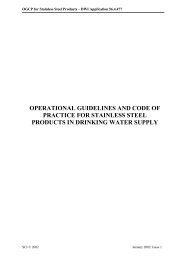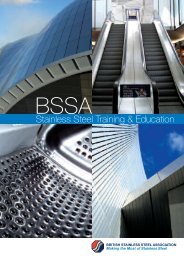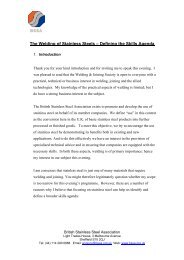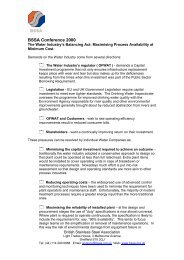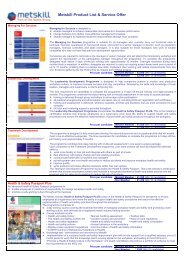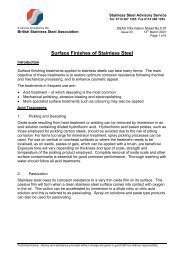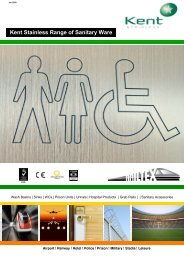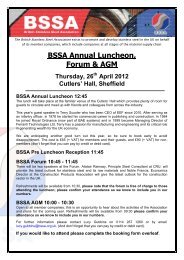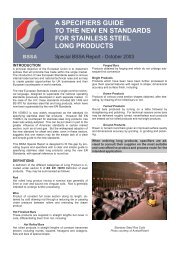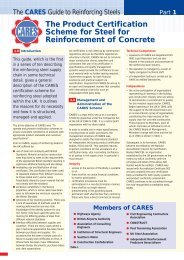SSAS2.81-Magnetic Properties.pdf - British Stainless Steel Association
SSAS2.81-Magnetic Properties.pdf - British Stainless Steel Association
SSAS2.81-Magnetic Properties.pdf - British Stainless Steel Association
You also want an ePaper? Increase the reach of your titles
YUMPU automatically turns print PDFs into web optimized ePapers that Google loves.
SSAS Information Sheet No.2.81<br />
Issue 01 1 st May 2000<br />
Page 2 of 2<br />
enable them to be readily weldable. This is achieved by ensuring that in their normal<br />
annealed (softened) condition, they contain a few percent of delta ferrite.<br />
This results in permeabilities slightly over 1.<br />
Additions of nickel and nitrogen promote and stabilise the austenite phase, whereas<br />
molybdenum, titanium and niobium stabilise ferrite<br />
The lowest permeability austenitic stainless steels are therefore the nitrogen bearing<br />
304LN (1.4311) and 316LN (1.4406) types or the high nickel 310 (1.4845) and 305<br />
(1.4303) types.<br />
In contrast, higher permeabilities can be expected in grades such as 301(1.4310), 321<br />
(1.4541) & 347 (1.4550), with either lower nickel contents or additions of titanium or<br />
niobium, which are powerful ferrite stabilising elements.<br />
During the welding of these steels, structural changes occur. Some of the austenite, in<br />
the parent material, can transform to delta ferrite at high temperatures and on cooling this<br />
is partly retained at room temperature. Welding filler rods and wires are usually<br />
"overalloyed" to prevent dilution in the fusion zone but more importantly are balanced to<br />
have deliberately high ferrite levels of 5% or sometimes 10%, to minimise the risk of hot<br />
cracking during welding.<br />
Consequently the permeability of the metal in the weld, and the surrounding heat affected<br />
zone, can be significantly higher than in the original parent material. Similar effects can<br />
occur following plasma or flame cutting austenitic stainless steels.<br />
Cold Work and Heat Treatment Effects<br />
Cold working of austenitic stainless steels can partially transform austenite to martensite.<br />
As martensite is "ferromagnetic" this means that austenitic types which would be<br />
expected not attract a magnet can show a degree of "pull".<br />
This usually occurs at sharp corners, sheared edges or machined surfaces but can be<br />
detected on wrought products such as rods or bars which may have been cold<br />
straightened, following the final hot rolling or annealing in the mill.<br />
The degree to which this occurs depends on the compositional effects of austenite<br />
stabilising elements noted above, high nickel or nitrogen bearing grades tolerating more<br />
cold working before localised increases in permeability are noticed.<br />
These increases in permeability can be reversed by a full solution annealing (at<br />
temperatures around 1050 / 1100 °C with rapid cooling). This transforms any cold-formed<br />
martensite back to austenite, the non-magnetic phase, which is then retained on cooling.<br />
The best austenitic stainless steel types for low permeability applications are those with<br />
high austenite stability as these have low permeability in both annealed or cold worked<br />
conditions.<br />
These include the nitrogen bearing types, 304LN (1.4311) and 316LN (1.4406) or the<br />
high nickel types such as 310 (1.4845).<br />
This Information Sheet is based on a draft supplied by Avesta Sheffield Ltd.<br />
Technical Advice: Advice and assistance provided without charge are given in good faith but without responsibility



